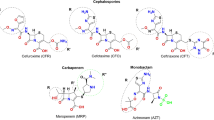Abstract
A two-step zero-length cross-linking procedure using active esters was successfully adopted for conjugating enrofloxacin (EF) to human serum albumin (HSA). The derived conjugate was characterized by UV spectrum and then used for immunization of BALB/C mice. In enzyme-linked immunosorbent assay (ELISA) and competitive inhibition ELISA experiments, the derived antiserum exhibited high antibody titer (greater than 1:250 000) as well as varied cross-reactivity (from 97.8% to 161.7%) to three analogs of EF belonging to fluoroquinolones family. But over the concentration range studied, no significant cross-reactivity was observed to other group of antibiotics (chloramphenicol, oxytetracycline, sulphamethoxazole and nysfungin). It was confirmed that the synthesized immunogen was highly antigenic and elicited specific antibody responses in BALB/C mice against EF.
Similar content being viewed by others
References
Bucknall, S., J. Silverlight, N. Coldham, L. Thorne, and R. Jackman, 2003. Antibodies to the quinolones and fluoroquinolones for the development of generic and specific immunoassays for detection of these residues in animal products. Food Additives and Contaminants, 20(3): 221–228.
Chan, E. C. Y., and P. Ho, 2002. Preparation and characterization of immunogens for antibody production against metanephrine and normetanephrine. Immunol. Methods, 266:143–154.
Chen, F. S., X. C. Luo, and Q. Zhou, 1999. Immunological detection of af latoxin B1II production and application of anti-AFBx antibody. Mycosystema, 18(4): 409–414.
Deng, G.D., G.X. Yang, and Z. L. Chen, 2000. Advance of the research on the residues detection of fluoroquinolones in food-producing animals. Chinese Journal of Veterinary Drug, 34(3): 53–58.
Duan, J. H., and Z. H. Yuan, 2001. Development of an indirect competitive ELISA for ciprofloxacin residues in food animal edible tissues. J. Agric. Food Chem., 49(3): 1 696–1 700.
Hiroo, W., S. Atsuko, K. Yasumasa, and T. Akio, 2002. Monoclonal-based enzyme-linked immunosorbent assay and immunochromatographic assay for enrofloxacin in biological matrices. Analyst, 127:98–103.
Hong, X. Z., and M. Q. Sun, 1993. The Conjugation Techniques of Proteins. Chinese Medical Science and Technology Press, Beijing, 3–4.
Kamps, H.C., S. Buckley, and L. Stanker, 1997. Production and characterization of monoclonal antibodies agaist sarafloxacin and cross-reactivity studies of related. J. Agric Food Chem., 45:1 984–1 990.
Spinks, C. A, 2000. Broad-specificity immunoassay of low molmecular weight food contaminants: new paths to Utopia. Trends in Food Science & Technology, 11: 210–217.
Zhou, X. M., L. Y. Chen, H. D. Wang, and Z. Y. Wang, 2003. The establishment and primary application of ELISA protocol for detecting SMD residue. Animal Husbandry & Veterinary Medicine, 35(10): 8–11.
Author information
Authors and Affiliations
Corresponding author
Rights and permissions
About this article
Cite this article
Liu, C., Lin, H., Cao, L. et al. Anti-enrofloxacin antibody production by using enrofloxacin-screened HSA as an immunogen. J Ocean Univ. China 4, 262–266 (2005). https://doi.org/10.1007/s11802-005-0045-z
Received:
Accepted:
Issue Date:
DOI: https://doi.org/10.1007/s11802-005-0045-z




